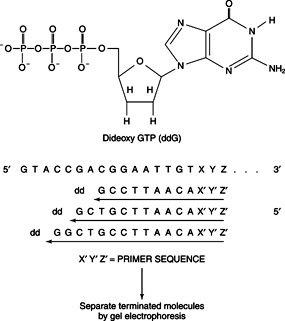The most important information about DNA is its nucleotide sequence. DNA sequences are determined by exploiting the enzymatic characteristics of DNA polymerase. DNA polymerases all require a primer to initiate synthesis. The sequencing reaction begins when a single primer is hybridized to the strand of DNA to be sequenced. This primer-initiated synthesis is just like the initiation of a PCR. The primer used to initiate synthesis can be complementary to the vector in which the DNA is cloned, or it can be a primer used to amplify the DNA in PCR. The important point for sequencing DNA is that all of the newly synthesized molecules will have the same sequence. The primer is extended by addition of deoxynucleoside triphosphates along with DNA polymerase. If these were the only components of the reaction mixture, then all the newly extended molecules would be complementary to the entire template chain, just as in PCR. The sequencing reaction also contains, in addition to the four deoxynucleoside triphosphates (dNTPs), 2′,3′-dideoxynucleoside triphosphates, or ddNTPs (ddGTP, ddATP, ddTTP, or ddCTP), as shown in Figure
1 .
As the preceding figure shows, the ddNTPs lack both the 2′ and 3′ hydroxyl groups of a ribonucleoside triphosphate; therefore, if a ddNTP is incorporated into the growing DNA chain, all synthesis stops. Because a ddNTP must be base-paired for it to be inserted into a chain, the incorporation of a dideoxynucleotide at a position is an indicator of the nature of the complementary base on the chain. In other words, ddG is incorporated into the chain only when a C is present in the template, ddA only in response to a T, and so on. Because either a deoxy- or dideoxynucleotide may be inserted at a given site, the result is a set of nested chains, beginning at the primer and ending at a dideoxynucleotide. The members of this collection of molecules all have the same 5′ end (because they all start with the same primer) and their 3′ ends terminate with a dideoxynucleoside. If the molecules are separated according to chain length by electrophoresis through a thin polyacrylamide gel, then the nucleotide sequence of the corresponding DNA can be read directly. The DNA fragments are detected by fluorescence. Sequences are read automatically from a single lane because each terminator is modified to contain a different fluorescent dye, so that each dideoxynucleoside is associated with a single color of the fluorescence. By using these methods, it is possible to read 700 or more nucleotides in a single experiment.

0 comments:
Post a Comment